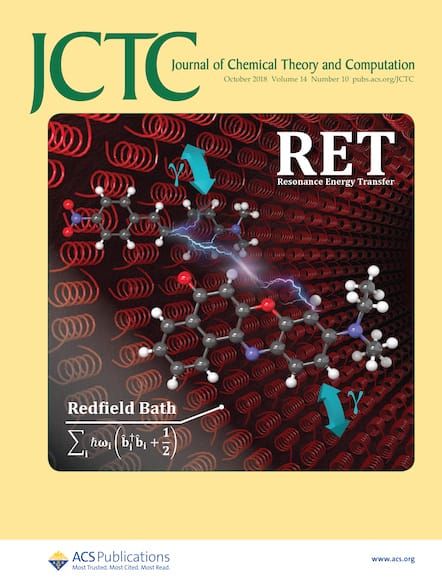Halogen Bonding on Water─A Drop in the Ocean?
IF 5.7
1区 化学
Q2 CHEMISTRY, PHYSICAL
引用次数: 0
Abstract
Halogen bonding is a valuable interaction in drug design, offering an unconventional way to influence affinity and selectivity by leveraging the halogen atoms' ability to form directional bonds. The present study evaluates halogen-water interactions within protein binding sites, demonstrating that targeting a water molecule via halogen bonding can in specific cases contribute beneficially to ligand binding. In solving and examining the crystal structure of 2-cyclopentyl-7-iodo-1H-indole-3-carbonitrile bound to DYRK1a kinase, we identified a notable iodine-water interaction, where water accepts a halogen bond with good geometric and energetic features. This starting point triggered further investigations into the prevalence of such interactions across various halogen-bearing ligands (chlorine, bromine, iodine) in the PDB. Using QM calculations (MP2/TZVPP), we highlight the versatility and potential benefits of such halogen-water interactions, particularly when the water molecule is a stable part of the binding site's structured environment. While the interaction energies with water are lower compared to other typical halogen bond acceptors, we deem this different binding strength essential for reducing desolvation costs. We suggest that "interstitial" water molecules, as stable parts of the binding site engaging in multiple strong interactions, could be prime targets for halogen bonding. Further systematic studies, combining high-resolution crystal structures and quantum chemistry, are required to scrutinize whether halogen bonding on water is more than a "drop in the ocean".水的卤素键合--沧海一粟?
卤素键是药物设计中一种有价值的相互作用,它提供了一种非传统的方法,通过利用卤原子形成定向键的能力来影响亲和力和选择性。本研究对蛋白质结合位点内的卤素-水相互作用进行了评估,证明在特定情况下,通过卤素键瞄准水分子可对配体结合产生有益的影响。在解析和研究与 DYRK1a 激酶结合的 2-环戊基-7-碘-1H-吲哚-3-甲腈的晶体结构时,我们发现了一种显著的碘-水相互作用,在这种相互作用中,水接受了具有良好几何和能量特征的卤素键。以此为起点,我们进一步研究了 PDB 中各种含卤配体(氯、溴、碘)之间这种相互作用的普遍性。通过使用 QM 计算(MP2/TZVPP),我们强调了这种卤素-水相互作用的多样性和潜在益处,尤其是当水分子是结合位点结构环境的稳定部分时。虽然与其他典型的卤素键受体相比,水的相互作用能较低,但我们认为这种不同的结合强度对于降低脱溶成本至关重要。我们认为,"间隙 "水分子作为结合位点的稳定部分,参与多种强相互作用,可能是卤素键的主要目标。我们需要结合高分辨率晶体结构和量子化学进行进一步的系统研究,以仔细研究卤素键合在水中是否不仅仅是 "沧海一粟"。
本文章由计算机程序翻译,如有差异,请以英文原文为准。
求助全文
约1分钟内获得全文
求助全文
来源期刊

Journal of Chemical Theory and Computation
化学-物理:原子、分子和化学物理
CiteScore
9.90
自引率
16.40%
发文量
568
审稿时长
1 months
期刊介绍:
The Journal of Chemical Theory and Computation invites new and original contributions with the understanding that, if accepted, they will not be published elsewhere. Papers reporting new theories, methodology, and/or important applications in quantum electronic structure, molecular dynamics, and statistical mechanics are appropriate for submission to this Journal. Specific topics include advances in or applications of ab initio quantum mechanics, density functional theory, design and properties of new materials, surface science, Monte Carlo simulations, solvation models, QM/MM calculations, biomolecular structure prediction, and molecular dynamics in the broadest sense including gas-phase dynamics, ab initio dynamics, biomolecular dynamics, and protein folding. The Journal does not consider papers that are straightforward applications of known methods including DFT and molecular dynamics. The Journal favors submissions that include advances in theory or methodology with applications to compelling problems.
 求助内容:
求助内容: 应助结果提醒方式:
应助结果提醒方式:


